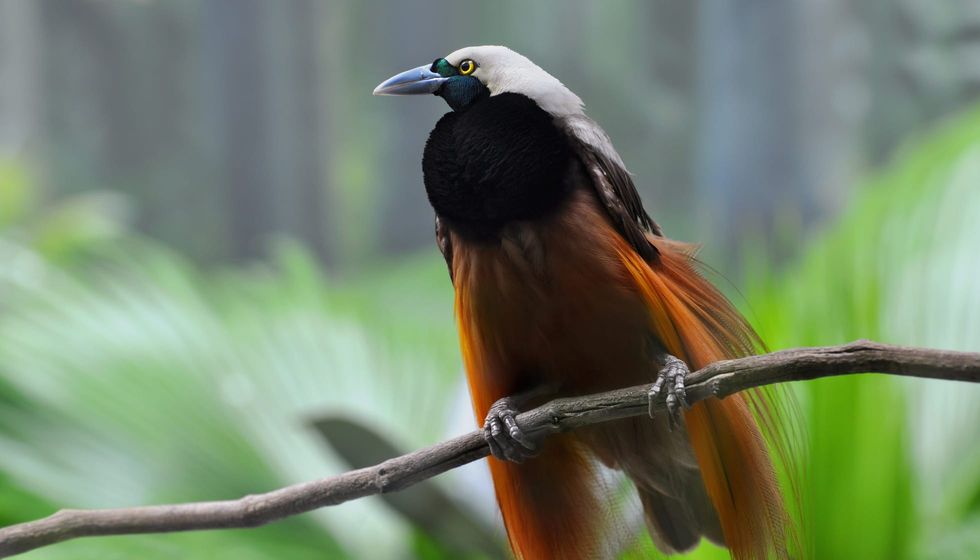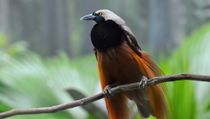One of the most extraordinary birds is the superb bird-of-paradise.
It is not only its unique appearance but also certain attributes that are present in this bird that distinguish it from the rest.
The Paradisaeidae family consists of 45 different species and is geographically distributed across the mountainous and rainforest regions of Australia and Papua New Guinea. The superb bird-of-paradise is dubbed as the greater Lophorina and this greater superb bird-of-paradise is identified for its plumage and unusual display of mating which involves dance and a loud call.
Until 2018, the superb bird-of-paradise was classified as the only species under the genus Lophorina, but now there are two other species: the lesser Lophorina (also known as the lesser superb bird-of-paradise or Lophorina superba minor) and the crescent-caped Lophorina (also titled the Vogelkop superb bird-of-paradise, the curl-caped bird or Lophorina niedda).
To get to knowmore intriguing facts about superb bird-of-paradise keep reading this article and for more relatable content, check out these greater blue-eared starling facts and great curassow facts for kids.
Superb Bird-Of-Paradise Interesting Facts
What type of animal is a superb bird-of-paradise?
These extraordinary creatures are bird species of the Paradisaeidae family. They are identified for their dance and feathers.
What class of animal does a superb bird-of-paradise belong to?
The greater superb bird-of-paradise (Lophorina superba), the Vogelkop superb bird-of-paradise (Lophorina niedda), and the lesser superb bird-of-paradise (Lophorina superba minor) all belongto the class of Aves and the genus Lophorina.
How many superb birds-of-paradise are there in the world?
These birds are widely distributed in South America but the exact number of birds that are present in their territories is not currently known.
Where does a superb bird-of-paradise live?
The superb bird-of-paradise (Lophorina superba) inhabits regions in Papua New Guinea where there is sufficient vegetation for foraging. The Vogelkop superb bird-of-paradise inhabits western parts of New Guinea.
What is a superb bird-of-paradise's habitat?
The superb bird-of-paradise prefers rainforest and sometimes mountainous habitats in Papua New Guinea and Indonesia.
Who do superb birds-of-paradise live with?
The social nature of the superb bird-of-paradise is not well-documented. However, it is known that other birds-of-paradise range between solitary birds and social ones, depending on the species.
How long does a superb bird-of-paradise live?
The average lifespan of these birds is between five to eight years.
How do they reproduce?
The superb bird-of-paradise displays sexual dimorphism as males have black plumage, blue-green breasts, and a cape on their back, while females are reddish-brown with a buff ventral region. The size difference between males and females is negligible and competition is extreme for mating.
The superb bird-of-paradise is a polygynous bird with unusual courtship displays that involve two phases.
The first phase includes simple actions and it is followed by another phase that involves a more elaborate and intense display. The male produces a loud cry to attract the female bird's attention.
After the female approaches, the male spreads its folded cape and breast shield upward around the head which transforms the male into an ellipse shape bird.
After the physical transformation, the male bird starts its mating dance, a 'dance floor' is prepared by removing dirt and leaves from the branches of the tree. The superb bird-of-paradise mating dance involves snapping the feathers of the tail while hopping and encircling the female to a definite rhythm.
The female may or may not choose to mate, and females often reject a lot of males.
The entire process of courtship, including the dance, is prolonged and may take almost a day. After mating, the average litter size is one to three eggs and these are hatched after 16-22 days.
What is their conservation status?
The superb bird-of-paradise is widely distributed in forest habitats in Papua New Guinea and this species is not endangered. These birds with fascinating courtship rituals and feathers are listed as Least Concern by the IUCN. However, the conservation status of the Vogelkop superb bird-of-paradise and the lesser superb bird-of-paradise is not listed.
Superb Bird-Of-Paradise Fun Facts
What do superb birds-of-paradise look like?
The greater superb bird-of-paradise, the Vogelkop superb bird-of-paradise, and the lesser superb bird-of-paradise all possess unique physical attributes. Ultimately, these birds are recognized for their extraordinary plumage.
Being sexually dimorphic, males have black plumage with a combination of a blue and green breast shield, while females have a more reddish-brown plumage. The feathers of these birds transform once they initiate the courtship process and the feathers form oval or crescent shapes over their head.

*Please note that this is an image of a Raggiana bird-of-paradise, not a superb bird-of-paradise. If you have an image of a superb bird-of-paradise please let us know at hello@kidadl.com.
How cute are they?
This small bird species appears extremely adorable. The bird's small head coupled with its tiny size makes it extremely cute, like mountain bluebirds.
How do they communicate?
This species of bird communicates during the breeding season by being vocal. The loud cry of the male birds attracts female birds and this loud call is followed by the male bird carrying out an elaborate courtship ritual to persuade females to mate.
How big is a superb bird-of-paradise?
This species of the genus Lophorina is a group of small birds and they have an approximate length of 9.8-10.2 in (25-26 cm). They are shorter than red birds-of-paradise.
How fast can a superb bird-of-paradise fly?
The speed of this species is not currently known.
How much does a superb bird-of-paradise weigh?
The weight of males is approximately 0.1-0.2 lb (60-105 g) and females weigh 0.2 lb (85 g). They are heavier than a common kingfisher.
What are the male and female names of the species?
The male bird is called a 'cock' and the female bird is called a 'hen'.
What would you call a baby superb bird-of-paradise?
These young birds are referred to as hatchlings when they are first born.
What do they eat?
This bird’s diet consists of fruits and arthropods.
Are they dangerous?
They are mostly harmless and not dangerous, unlike a goshawk.
Would they make a good pet?
These birds are supposed to be a free species, even though some people do keep them as a pet. Despite this, this species belongs in the wild so it is recommended not to keep them in captivity. If too many people keep them as pets, their population might decline.
Did you know...
The word ‘Lophorina’ in the bird’s scientific name means 'tuft', this is based on the upward standing tuft of feathers above their head.
Males do not develop their adult plumage rapidly and it can take as long as seven years for this to develop fully. All this waiting pays off though, as they are able to perform an elaborate courtship ritual (forming an ellipse over their head) once their plumage is fully developed.
Naming the superb bird-of-paradise bird
When the bird-of-paradise was first introduced to Europe in the 15th century, some people related this bird to the phoenix (which is a mythical character) due to its unusual appearance. The name 'bird-of-paradise' is derived from early diction which referred to these birds as ‘birds of God’.
When was the superb bird-of-paradise discovered?
The exact date of the discovery of the superb bird-of-paradise is not known, but the Vogelkop superb bird-of-paradise species was first defined by Ernst Mayr in 1930. At this time it was considered as a subspecies of the greater superb bird-of-paradise.
Until 2018, the greater superb bird-of-paradise was considered as the only species of the genus Lophorina but now the Vogelkop superb bird-of-paradise and the lesser superb bird-of-paradise are recognized as species of the genus Lophorina too.
Here at Kidadl, we have carefully created lots of interesting family-friendly animal facts for everyone to discover! Learn more about some other birds from our goldcrest surprising facts and giant kingfisher facts for kids pages.
You can even occupy yourself at home by coloring in one of our free printable superb bird-of-paradise coloring pages.
*Please note that the main image is of a Wilson bird-of-paradise, not a superb bird-of-paradise. If you have an image of a superb bird-of-paradise please let us know at hello@kidadl.com.









